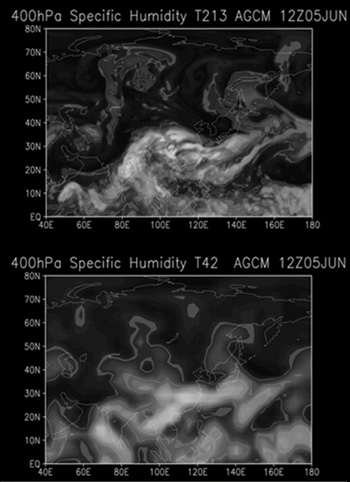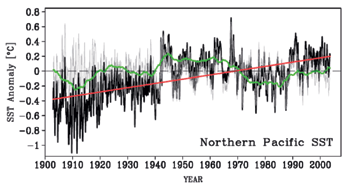Near-Term Climate Prediction
Climate 2030
Near-term climate prediction using a high-resolution coupled ocean-atmosphere general circulation model
Future climate prediction up to the year 2030 is planned using a global climate model with 60-km atmospheric resolution coupled with a 20 x 30 km eddy-permitting ocean model. The research goal is to provide a basis for more quantitative assessment of regional climate change, including change in extreme weather events, so that more realistic strategies and risk-management options can be developed.
The model will be initialized using decades of observed climate data. Ensemble integrations into the future will provide measures of uncertainty. Whether such a prediction as an initial-value problem is feasible or not in the global warming projection is a great scientific challenge. The development and investigation of an initialization and ensemble prediction methodology are novel aspects of this research. The coupled model will take into account not only increases in greenhouse gases, but also increases in emissions of various aerosols of anthropogenic origin.
Model development
The physics and resolution of the Model for Interdisciplinary Research on Climate(MIROC) atmosphere-ocean coupled climate model will be upgraded for better representation of both global climate and regional extremes. The model has been developed cooperatively by the Center for Climate System Research (CCSR) of the University of Tokyo, the National Institute for Environmental Studies (NIES), and the Frontier Research Center for Global Change (FRCGC) of the Japan Agency for Marine-Earth Science and Technology (JAMSTEC). The model has provided projection data with high spatial resolution that have been used in the IPCC's Fourth Assessment Report. The new version of the model will include 60-km atmospheric resolution and a 20 x 30 km eddy-permitting ocean model, which will help to represent heavy rain disturbances and local ocean current systems. The parameterization of clouds, the boundary layer, aerosols, and sea ice physics will be upgraded for better reproducibility of past and present climate.

Fig1. Simulations of upper-air (7-km height) moisture content over the summertime Asian monsoon using a 60-km (upper) and 300-km (lower) mesh models.
Improvement of future climate change projection by developing a high-performance ocean model
This research aims to improve the future prediction ability of climate models by developing a sophisticated global ocean model. Particular emphasis will be placed on the area around Japan. Based on an already existing 20-km grid global ocean model that can represent small-scale ocean eddies, particularly high resolution will be achieved around Japan. For other regions, processes will be studied using regional fine-resolution models; the results should provide better climate reproducibility at 20-km resolution. Once developed, the previous ocean component of the model will be replaced, and research will verify the extent to which this high-performance ocean model improves the quality of future climate projection.
Development of a technique to quantify the uncertainty in near-term climate prediction using ensemble data assimilation
An ensemble data assimilation technique to quantify the uncertainty in the reproduction and prediction of longterm climate change using a dynamical model will be developed. The technique will be used to create optimal initial conditions for near-future climate prediction and to estimate the uncertainty involved in the reproduced and predicted climate states. The main focus will be on the accurate reproduction of ocean conditions. The developed technique will be applied to the final experiment of near-term climate prediction.

Fig2. A time series of observed sea surface temperature (SST; 20N - 60N, 140E - 120W; black) is decomposed into a global warming trend (red), a decadal component (green), and the rest (gray). The decadal component is comparably large to the trend, and therefore it is important how well the component is reproduced and predicted in the system developed.
Estimation of changes in the risk of water-related disasters based on near-term climate prediction with uncertainty considerations
A comprehensive hydrological cycle model will be developed. The outputs from the high-resolution climate model, which will be developed by the subgroup of the project described above, will be used as the inputs to the model. Hydrological quantities that are strongly related to water hazards, e.g., river discharge and soil moisture, will then be simulated using the hydrological cycle model. The simulation results will be compared with simulation results for the 20th century, and changes in the risk of water-related disasters will be estimated.

Fig3. Projected return period [year] of the 100-year floods in the present-day (1901-2000) simulation during a) 2001-2030 and b) 2071-2100 by MIROC.